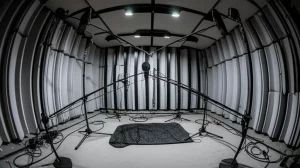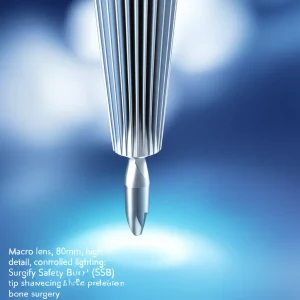The Material That Bends the Rules: Switchable Stiffness and Elasticity!
Alright, let’s talk about materials. For the longest time, it felt like you had to pick a side: either something was super stiff and strong, like ceramics (think bone, but brittle!), or it was stretchy and flexible, like rubber or plastic. Getting both in one package? That was the holy grail, especially when you look at amazing natural stuff like bone and seashells, which manage to be both tough *and* resilient thanks to their clever mix of hard and soft bits.
Trying to make artificial materials that do this has been a real puzzle. The biggest challenge? Getting those stiff, inorganic parts to play nicely and bond strongly with the soft, organic ones. It’s like trying to glue rocks and jelly together – tricky!
But here’s where things get exciting. What if we don’t just mix them randomly, but engineer the structure at a tiny level? That’s the idea behind mechanical metamaterials. They get their amazing properties not just from what they’re made of, but *how* they’re put together.
In this study, we’ve cooked up something pretty special: a calcium phosphate-based inorganic-organic hybrid metamaterial, or CIOHM for short. Think of it as a clever blend where tiny inorganic nanoparticles are held within a network of long, flexible polymer chains, and then rigid inorganic blocks are firmly tied to this network using short, organic crosslinkers.
And guess what? This material is a bit of a chameleon. It can switch between being super stiff and remarkably elastic, and we can even fine-tune just how stiff or elastic it is. Plus, and this is huge, it’s shown excellent compatibility with living things in both lab tests and when implanted in rats. This opens up a whole world of possibilities for using it in medicine.
The Magic Behind the Switch
So, how does this CIOHM pull off its disappearing act between stiff and elastic? It’s all thanks to its unique internal architecture, which we call the Long-chain/Short-chain Dual Inorganic-Organic Crosslinking Network (L/SDIOCN).
Imagine a scaffold made of flexible, long polymer chains. Inside this scaffold, we’ve trapped tiny calcium phosphate (CaP) nanoclusters. Now, we introduce rigid CaP blocks, derived from other calcium phosphate components. The crucial part is a short-chain organic molecule, citric acid (CA), which acts like a molecular bridge. It grabs onto the CaP nanoclusters embedded in the polymer network and also grabs onto the rigid CaP blocks.
This creates a network where the rigid blocks are firmly anchored to the flexible polymer matrix. In its initial state, when it’s dry (we call this the ground state, or CIOHM-GS), the rigid CaP blocks dominate, making the material stiff and strong, much like traditional ceramics but with better fracture resistance thanks to the organic network.
But introduce water, and the game changes! The polymer network starts to swell, soaking up the water. This increases the space between the rigid CaP blocks. Even though the blocks are still connected by those strong CA links, the expanded, water-filled polymer network takes over the mechanical behavior. The material becomes soft, pliable, and incredibly elastic (the hydration state, or CIOHM-HS). It can deform significantly under pressure or tension and then bounce back when the force is removed.
This switch isn’t just a one-time trick; it’s completely reversible! You can hydrate it to make it elastic, let it dry to make it stiff again, and repeat the process many times without losing its cool properties.

Putting it to the Test: Strength and Stretch
We put this CIOHM through its paces to see just how tough and flexible it really is, comparing it to traditional calcium phosphate cements (CPCs). And let me tell you, the results were impressive.
Traditional CPCs are stiff, yes, but they’re also brittle. Apply too much stress, and *snap* – they fracture suddenly. Our CIOHM-GS is stiff too, but it shows a much more graceful response under compression. It deforms plastically, meaning it can handle significant strain before reaching its limit. This is thanks to the rigid CaP blocks rearranging within the resilient polymer network.
When we hydrate it to CIOHM-HS, it’s a totally different story. Under compression, it initially deforms easily with very little stress, showing off that water-induced swelling and polymer elasticity. But even then, the strong links keep the rigid blocks tethered, so as you compress further, the stress ramps up significantly. This adaptable behavior is exactly what makes it a mechanical metamaterial.
In tension, the difference is even more striking. Traditional CPCs barely stretch before breaking. Our CIOHM-HS, however, can stretch by nearly 20% before fracturing! That’s a massive leap in flexibility.
We also looked at toughness – basically, how much energy a material can absorb before breaking. CIOHM-GS is orders of magnitude tougher than traditional CPC. And the ability to switch between states? It’s super reliable. We put CIOHM through ten cycles of hydration and dehydration, and it kept its mechanical integrity beautifully. Even after soaking in a body-like solution for over two months, it still performed like a champ and could switch states. It even handles temperature changes well, from cool to warm.
We found we could actually tune the material’s properties by adjusting the amount of citric acid we used. More CA means more crosslinking, leading to higher stiffness in the ground state, though it slightly reduces toughness. This means we can potentially tailor the material’s properties for different jobs.
Playing Nice: Biocompatibility
Okay, so it’s strong, flexible, and switchable – but can we actually use it inside the body? That’s where biocompatibility comes in, and the news is really good.
In lab tests, we saw human bone marrow stem cells happily sticking to the CIOHM surface and growing robustly. Cell viability tests showed no significant negative impact from the material. We also checked how it interacts with immune cells, and it seems to have only mild effects, which is exactly what you want for an implantable material.
Another critical test for materials going into the body is checking if they cause red blood cells to burst (hemolysis). Our CIOHM had a minimal hemolytic rate, well within the safe limits for biomedical use. We also looked at blood clotting. It showed a slight effect on some clotting pathways, suggesting a mild anticoagulant property, but nothing that seemed concerning for localized use.

We didn’t stop there. We implanted CIOHM samples under the skin of rats to see how the body reacted over time. We monitored their health, checked their blood, and looked at major organs like the lungs, liver, and kidneys. The results were very encouraging – no abnormal symptoms, no significant changes in blood counts, and no signs of inflammation or damage in the organs even after eight weeks. This tells us the material has minimal systemic impact and is well-tolerated by the body.
Game-Changing Applications, Starting with Bone
Given its awesome properties and excellent biocompatibility, CIOHM is poised to be a real game-changer in translational medicine. Calcium phosphate materials are already used a lot as bone fillers to fix breaks and defects. But traditional bone cements are a bit of a hassle – you have to mix a powder and liquid right there in the operating room, and it takes time to set.
Our CIOHM offers a revolutionary alternative. We can make it into sterilized granules *before* the surgery. These granules are easy to handle and can be quickly placed into the bone cavity. Once implanted, they soak up body fluids and transition into their flexible, hydrated state. This expansion helps fill the space completely, eliminating gaps.
We tested this idea in rats with bone defects, and the results were fantastic. The CIOHM implants not only integrated well with the surrounding tissue but also actively promoted new bone formation. The material’s ability to become flexible after implantation seems to help cells infiltrate and tissue integrate early on, speeding up the healing process.

This “pre-made granule” approach could significantly streamline orthopedic surgeries, potentially cutting down on operating time and making procedures faster and safer for patients.
But the potential doesn’t stop at bone fractures. The unique combination of switchable mechanics, robustness, and biocompatibility makes CIOHM suitable for all sorts of implants and reconstructive surgeries, like potentially using it as a mandibular prosthesis. We’re excited to explore its use in other medical scenarios too.
Looking Ahead
Successfully creating CIOHM with its switchable high stiffness and elasticity is a big deal. It shows that by carefully engineering the linkages between inorganic and organic components at a molecular level, we can create bulk materials with truly extraordinary properties. The L/SDIOCN approach isn’t just for this specific material; it provides a powerful blueprint for designing a whole new class of advanced mechanical metamaterials that combine the best features of both the hard and soft worlds. This is just the beginning of what’s possible!
Source: Springer







